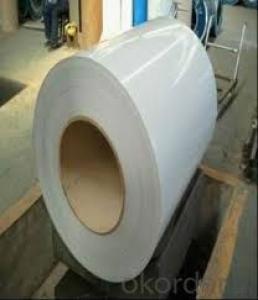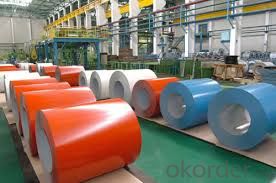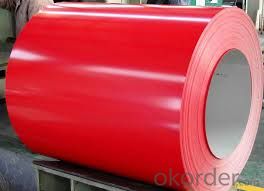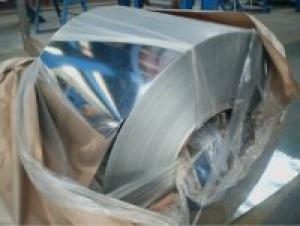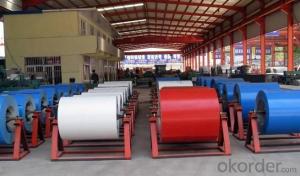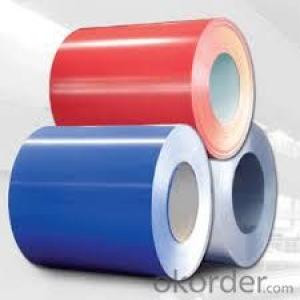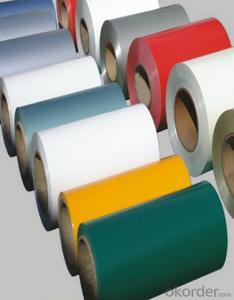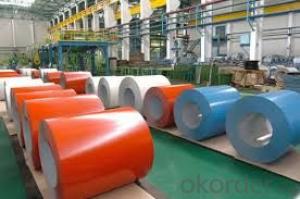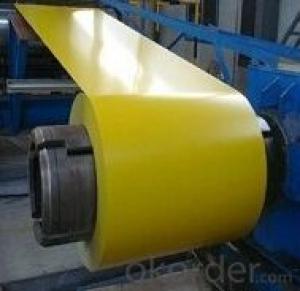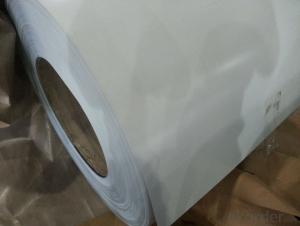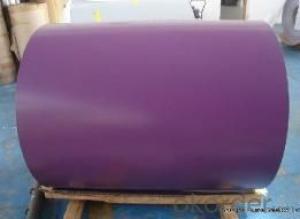Pre-Painted Galvanized (PPGI) Color Coated Steel Coil
- Loading Port:
- China main port
- Payment Terms:
- TT OR LC
- Min Order Qty:
- 25 m.t.
- Supply Capability:
- 1000 m.t./month
OKorder Service Pledge
OKorder Financial Service
You Might Also Like
Product Description
Pre-painted Galvanized Steel Coil
PPGI is made by cold rolled steel sheet and galvanized steel sheets as baseplate,
Through the surface pretreatment (degreasing, cleaning, chemical conversion
Processing), coated by the method of continuous coatings (roller coating method),
And after roasting and cooling.
SPECIFICATION
1. Standard: AISI, ASTM, BS, DIN, GB, JIS
2. Grade: DX51D+Z, DC51D, SPCC, SGCC, SGHC, CGCC,
3. Surface Treatment Coated: Galvanized, Paint sealant, Coating passivation solution
Substrate Cold rolled, Galvanized sheet
4. Color: RAL Color card
5. Coil ID: 508/610 mm
6. Coil weight: 4-10MT
7. Paint film Front side: 10~25um
Back side: 5~10um
8. Zinc layer: 40~180g per square meter
9. Thickness: 0.14~3.0mm
10. Width: 400~1500mm
11. Length: As requirement
12. Type: Steel plate, Steel Coil, Roofing metal
13. Place of origin: Shandong CHINA(mainland)
14. Deliver time: 20-30 days after receipt of advanced t/t or L/C
Advantages
1. Our company produce various specification and models and national standards of galvanized steel coil
2. Using high-quality material and advanced production technology and equipment for processing
3. Applicable to a humid climate and the harsh corrosive environment
4. Products has been all over the country more than 20 provinces, municipalities and
Autonomous regions, and have been exported to Europe, North American, the Middle East,
The South East Asia, Africa, Asia, European and other countries and regions, well received by our buyer.
commodity | Color-coated Galvanized Steel Coil (PPGI/ PPGL) |
Techinical Standard: | JIS G3302-1998, EN10142/10137, ASTM A653 |
grade | TSGCC, TDX51D / TDX52D / TS250, 280GD |
Types: | For general / drawing use |
Thickness | 0.14-2.0mm(0.16-0.8mm is the most advantage thickness)) |
Width | Width: 610/724/820/914/1000/1200/1219/1220/1250mm |
Type of coating: | PE, SMP, PVDF |
Zinc coating | Z60-150g/m2 or AZ40-100g/m2 |
Top painting: | 5 mic. Primer + 15 mc. R. M. P. |
Back painting: | 5-7 mic. EP |
Color: | According to RAL standard |
ID coil | 508mm / 610mm |
Coil weight: | 4--8MT |
Package: | Properly packed for ocean freight exportation in 20' ' containers |
Application: | Industrial panels, roofing and siding for painting / automobile |
Price terms | FOB, CFR, CIF |
Payment terms | 20%TT in advance+80% TT or irrevocable 80%L/C at sight |
delivery time | 25 days after recepit of 20% TT |
Remarks | Insurance is all risks |
MTC 3.1 will be handed on with shipping documents | |
We accept SGS certificatation test |
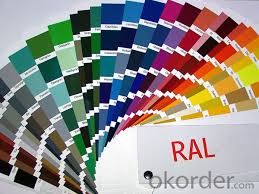
- Q: How are steel coils used in the manufacturing of shock absorbers?
- Steel coils are commonly used in the manufacturing of shock absorbers as they provide the necessary strength and flexibility to absorb and dampen shocks and vibrations. These coils are typically placed inside the shock absorber to support the weight of the vehicle and absorb the impact caused by uneven road surfaces. The coiled steel springs compress and expand to absorb the energy from the shocks, ensuring a smoother and more comfortable ride for the vehicle occupants.
- Q: What is the lifespan of steel coils?
- The lifespan of steel coils can vary depending on various factors such as the quality of the steel, the conditions in which they are stored or used, and the maintenance practices employed. However, with proper care and maintenance, steel coils can last for several decades or even longer.
- Q: How are steel coils used in the packaging industry?
- Steel coils are used in the packaging industry primarily for the production of metal strapping and seals. These coils are unwound and processed to create strong and durable strapping materials that are used to secure and bundle various types of packaging, such as boxes, crates, and pallets. The steel coils provide excellent tensile strength and resistance to breakage, making them ideal for ensuring the safe transportation and storage of goods.
- Q: Why is steel so important? How does it help us in everyday life?
- steel comes from iron. Iron is a natural resource and is abundent in nature. so being able to turn it into steel means it can be used for alllll sorts of things! from buildings, cars, piping and tubes, to washing machines, appliances and many other things. its used in our everyday life and is a great, strong material.
- Q: How are steel coils inspected for paint adhesion using adhesion testers?
- Steel coils are inspected for paint adhesion using adhesion testers in a systematic and rigorous manner. Adhesion testers are devices specifically designed to evaluate the bond strength between the paint and the underlying steel surface. The inspection process begins by selecting representative samples from the steel coils. These samples are usually cut into smaller sections, ensuring that they are free from any defects or surface irregularities that could affect the adhesion test results. Once the samples are prepared, the adhesion testers are employed to measure the force required to detach the paint coating from the steel surface. The most commonly used adhesion tester is the cross-cut adhesion tester. This device consists of a set of blades arranged in a grid pattern. The blades are used to create a series of cuts through the paint coating down to the steel surface, forming a grid of squares or rectangles. After the cuts are made, a specialized tape is applied to the grid area and pressed firmly onto the surface. The tape is then rapidly pulled off at a 90-degree angle to the surface. The force required to remove the paint coating from the steel is measured and recorded. The results of the adhesion test are evaluated based on predetermined standards or specifications. These standards typically define the minimum acceptable adhesion strength for the specific application or industry. If the measured adhesion strength falls below the specified threshold, it indicates poor paint adhesion, which could lead to issues such as paint delamination or corrosion. In addition to the cross-cut adhesion tester, other adhesion testing methods may also be used, such as the pull-off adhesion tester, where a hydraulic or mechanical device applies a tensile force to a small circular or dolly-shaped test area. The force required to pull off the dolly is measured and used to assess the paint adhesion. Overall, the use of adhesion testers ensures that steel coils are thoroughly inspected for paint adhesion. This helps to identify any potential adhesion issues early on, allowing for appropriate remedial measures to be taken to ensure the longevity and performance of the paint coating.
- Q: What are the different grades of steel used for making coils?
- There are several different grades of steel that are commonly used for making coils, depending on the specific application and requirements. Some of the most commonly used grades include: 1. Low carbon steel (also known as mild steel): This grade of steel is often used for making coils as it offers good formability, weldability, and machinability. It is suitable for a wide range of applications where strength and durability are not the primary requirements. 2. High carbon steel: This grade of steel contains higher levels of carbon, which provides increased strength and hardness. It is commonly used for making coils that require high strength and resistance to wear and tear, such as springs and automotive components. 3. Stainless steel: This grade of steel contains a high percentage of chromium, which provides excellent corrosion resistance. Stainless steel coils are commonly used in applications where resistance to rust and staining is crucial, such as kitchen appliances, automotive trim, and medical equipment. 4. Galvanized steel: This grade of steel is coated with a layer of zinc, which provides excellent corrosion resistance. Galvanized steel coils are commonly used in outdoor applications where exposure to moisture and other elements is a concern, such as roofing, fencing, and HVAC ductwork. 5. Electrical steel: This grade of steel is specially designed for use in electrical applications, such as transformers, motors, and generators. It has low levels of impurities and is optimized for high magnetic permeability and low core loss. 6. Advanced high-strength steel (AHSS): This grade of steel is engineered to provide exceptional strength while maintaining good formability. AHSS coils are commonly used in the automotive industry for lightweighting vehicles while ensuring structural integrity and crashworthiness. These are just a few examples of the different grades of steel used for making coils. The specific grade chosen will depend on factors such as the intended application, desired properties, and cost considerations.
- Q: How are steel coils used in the production of steel tanks?
- Steel coils are used in the production of steel tanks by being cut and shaped into the desired size and shape of the tank. These coils are typically made of high-quality steel, which provides strength and durability to the tanks. The coils are processed through various manufacturing techniques like rolling, bending, and welding to create the tank's body, ensuring a seamless structure. Additionally, the coils can also be used to create the tank's base, lid, and other components, resulting in a complete and sturdy steel tank suitable for various applications.
- Q: and also what makes different hardness of stainless steel?
- a little clarification. steel doesn't become stainless. There are many different types of steel, which is an alloy of iron and other element. The other elements determine things like hardness, corrosion resistance, etc. One element is chromium, which when added in the correct proportions, forms stainless steel. PS, there are many many different stainless steels, with different proportions.
- Q: How are steel coils used in the manufacturing of braking systems?
- Steel coils are used in the manufacturing of braking systems as they are commonly used to make brake pads and brake rotors. Steel coils are processed and shaped into the required forms to create these essential components, which play a crucial role in the braking system's functionality and performance.
- Q: What are the common surface finishes available for steel coils?
- Steel coils offer various surface finishes to meet specific application and aesthetic needs. One commonly used finish is hot-dip galvanized, which involves zinc coating the coil for excellent corrosion resistance in outdoor settings exposed to moisture and harsh weather. Another popular option is electro-galvanized, achieved by electroplating a thin zinc layer onto the coil. While it provides good corrosion resistance, it is not as durable as hot-dip galvanized. In addition, steel coils can be coated with paint or polymer to enhance appearance and provide extra corrosion protection. The coatings are available in different colors and finishes, such as matte or glossy, catering to specific aesthetic requirements. Furthermore, steel coils can undergo a mill finish, leaving them raw and untreated for future processing or coating. Other surface finishes include stainless steel, achieved through passivation to enhance corrosion resistance, and brushed or polished finishes for decorative purposes. Ultimately, the choice of surface finish depends on factors like intended use, environmental conditions, and desired appearance. Each finish offers unique advantages and characteristics.
Send your message to us
Pre-Painted Galvanized (PPGI) Color Coated Steel Coil
- Loading Port:
- China main port
- Payment Terms:
- TT OR LC
- Min Order Qty:
- 25 m.t.
- Supply Capability:
- 1000 m.t./month
OKorder Service Pledge
OKorder Financial Service
Similar products
Hot products
Hot Searches
Related keywords
